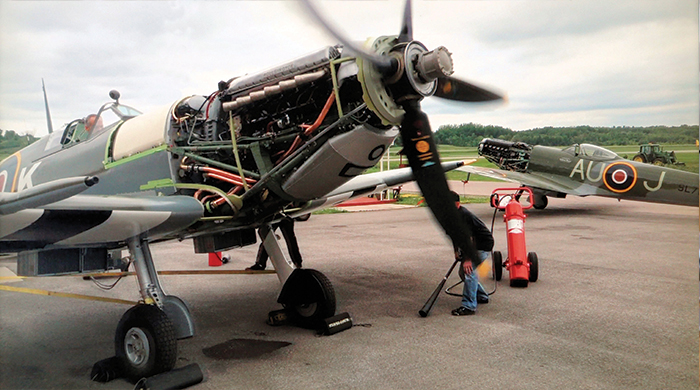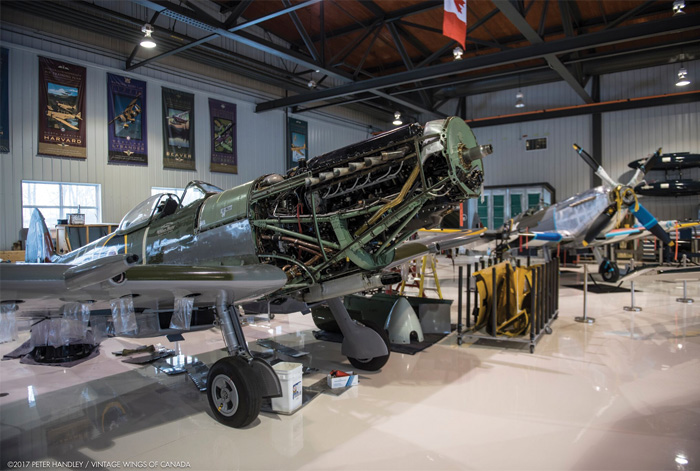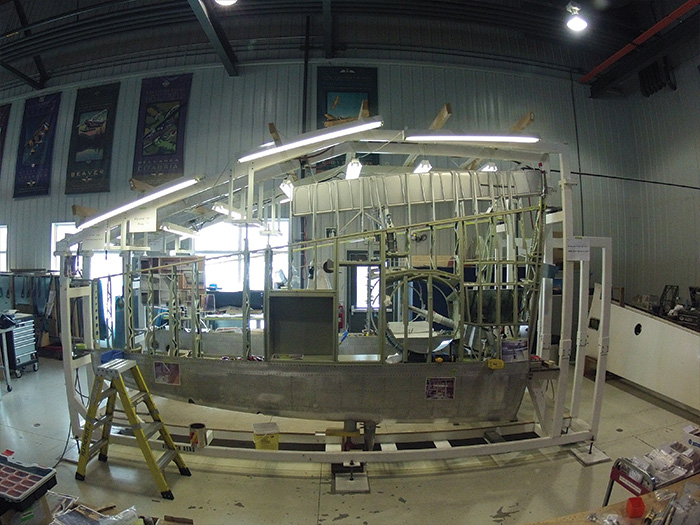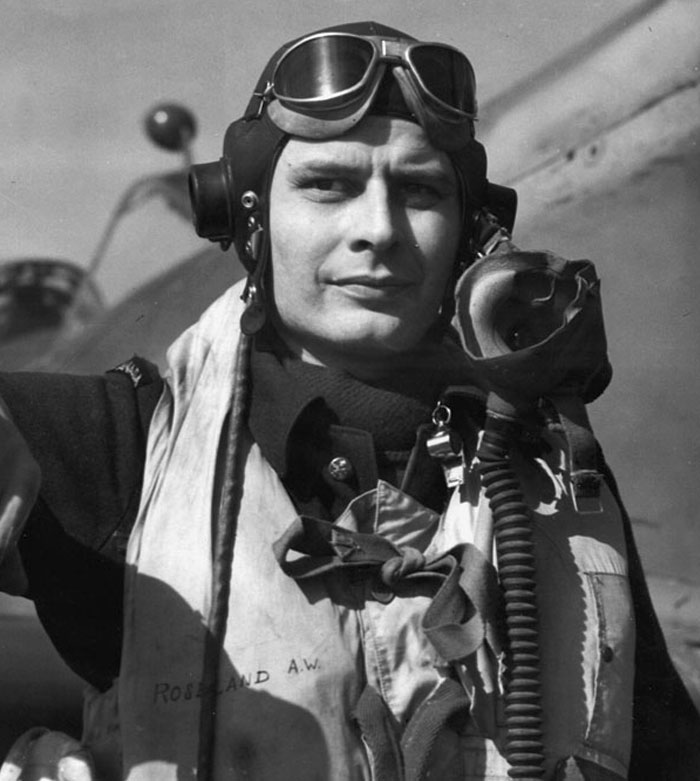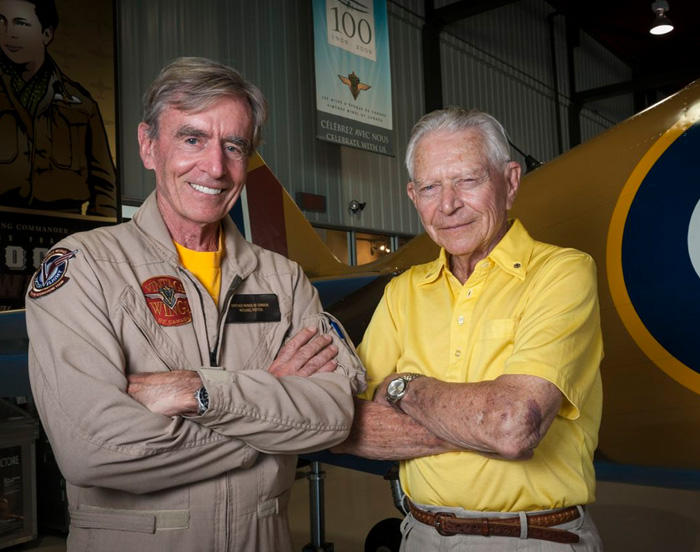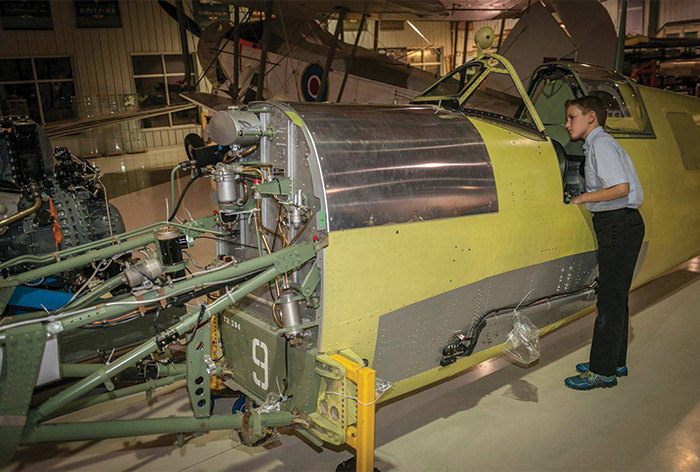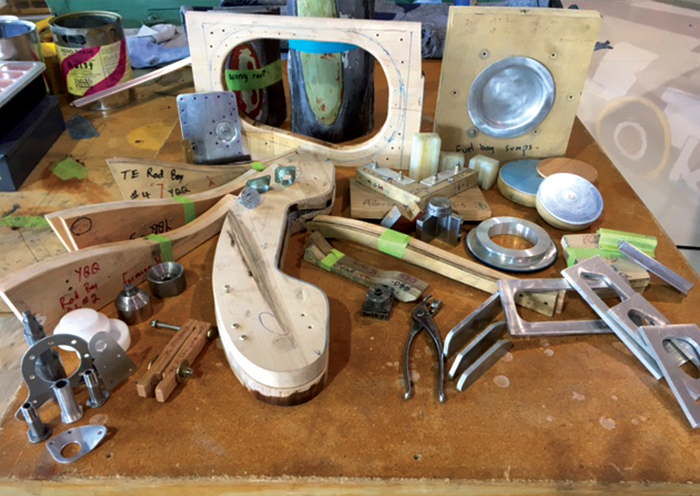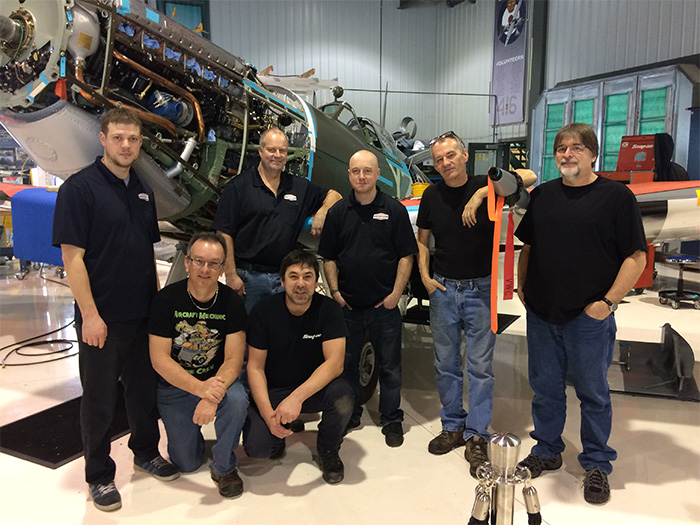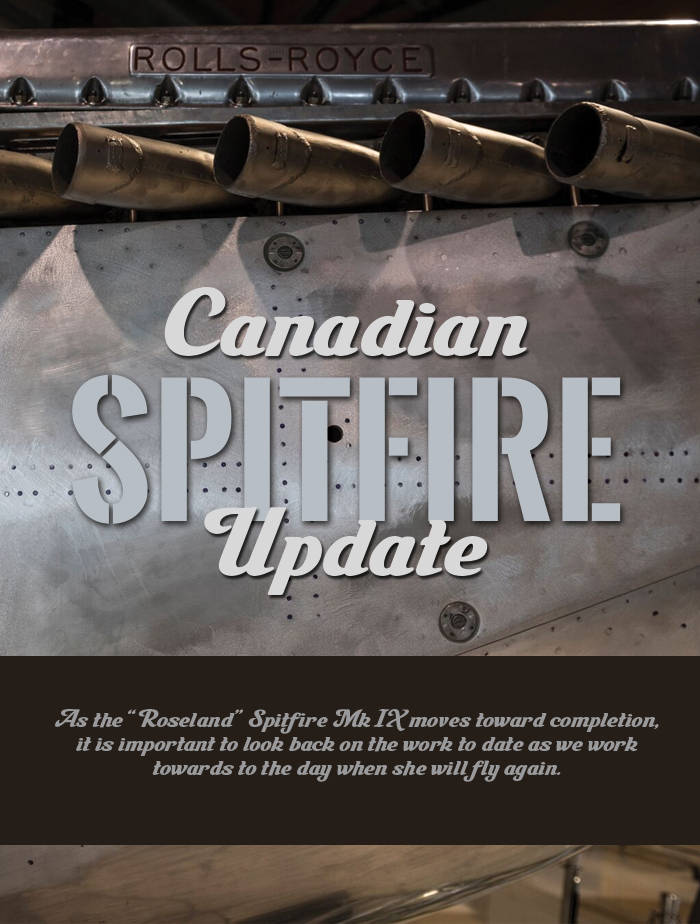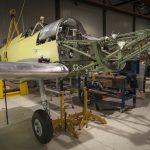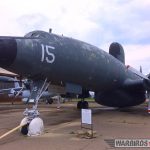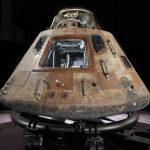In 1967, just 22 years after the end of the Second World War, when the producers of the epic motion picture Battle of Britain contracted with the legendary Group Captain Hamish Mahaddie, RAF to wrangle extant Spitfires from across the United Kingdom, there were only 14 airworthy examples in the world — from a full production run of more than 20,000 of all marks. The film production company restored another three Spitfires to round out the roster for the film as not all the owners of flyable Spits were keen on lending them for use in the film. According to Peter Arnold, who, along with Gordon Riley and Graham Trant, authored the two expansive volumes of Spitfire Survivors—Then and Now, 85 Spitfires have flown since that date. That’s a 600% increase in flyable airframes. Today he estimates that 56 Spitfires and Seafires are currently flyable. As early as 1960, author Bruce Robertson in Spitfire— Story of a Famous Fighter, put the number of survivors (airworthy and otherwise) at just 80. When a reprint of the same book came out in 1973 , that number had grown to 127. Today, Arnold, Riley and Trant have calculated that number to be 282 Spitfires (both flyable and non-flyable) and build projects under way. That extraordinary growth is the result of one thing—the belief held by certain people that a Spitfire should be free to dance the skies and tell the stories of those boys from so long ago. These people are the men and women of the warbird world and the people who fund them.
There are those who believe that an inanimate object as precious and as central to world history as a Supermarine Spitfire should be grounded, conserved, roped off and displayed to ensure its continued existence for all those who would study it. To fly it or even to take it out of doors is to diminish the lifespan of the object. To display it in anything but its original markings and condition is to alter history. To fly it is risking too much.
Then there are those who think it isn’t an inanimate object at all and should not be kept in captivity, no matter how well-intentioned. Historical artifacts are often experienced only through interpretation and sight. See it, read the plaque, move on. But a Supermarine Spitfire played its role in a very real world—one with smells, sounds and textures as well as visual qualities. As such, it is better understood in its environment—the environment that its pilots lived, fought and died in. With nearly all Second World War Spitfire pilots now dead, soon only the aircraft themselves will remain to tell the story.
Inanimate objects are those without a soul or life force, like a rock or a dinner plate, but a Spitfire has a soul, one that remains in its bones forever. That soul… that life force spread into its structure the first time a pilot plunked his ass on its seat and stroked its leather-wrapped spade-grip or toggled a switch with a finger tip. The smell of very human sweat and even blood are mixed with those of high octane petrol, glycol leaks and sun-heated paintwork. From that first moment on, the movements of its ailerons and its tail feathers, the pace of its heart beat, the heights to which it climbed and the vectors it followed were all expressions of a pilot’s desire. We can never look at a Spitfire and see only metal and fabric, for our perspective is altered by history, by youth, by blood and bone.
Soon, another aircraft will join the growing flock of free-range Spitfires—Supermarine Spitfire Mk IX, RAF serial number TE294. Twenty years ago, nothing more than a pile of rotting metal and loose components, TE294 had almost been subsumed by the earth from which she came—her aluminum and steel structure corroding and breaking down in a scrapyard in South Africa, her wings long gone, component parts stolen or vandalized. Only to someone who could recognize her broken, twisted and rusted bones was she still a Spitfire. In the 1990s, TE294 was rescued, the decline to dust arrested, and the long, long journey to living warbird commenced. From South Africa, her boxed bones travelled to British Columbia, Canada, where a group of passionate volunteers at the Comox Air Force Museum took on her daunting rebuild as a millennium project and as an homage to the wartime pilots of 442 Squadron, a Search and Rescue squadron of the Royal Canadian Air Force still residing on the flight line at 19 Wing, Comox.
In his nearly two years on P-40s and P-40 Kittyhawks before going to Europe, Rosey had 220 flights and 348 hours. For more on the life and death of Flight Lieutenant Walter Arnold “Rosey” Roseland, click HERE. (Photo via RCAF)
For a number of years, the Comox team made steady progress, but continued funding the extremely expensive enterprise became problematic. Mike Potter and Vintage Wings of Canada were approached to offer assistance in terms of expertise, facilities and above all funding. The transition of control to Vintage Wings was not without controversy and detractors, but the Comox Air Force Museum website explains it best: “In 2000, the Comox Air Force Museum, with a grant from the Y2K Millennium Fund, purchased TE 294 and embarked on the Y2K Spitfire Project. The project was funded entirely by donations and grants from the general public and the restoration proceeded slowly. By 2007 only the fuselage and tail section had been completed and it was becoming obvious that a massive infusion of cash would be needed if the project was to continue. In 2008, the Museum presented a decision paper to the Wing Commander of 19 Wing, Comox. It concluded that unless a new owner could be found the Museum would be compelled to shut the project down and dispose of the unfinished aircraft. The Wing Commander accepted the findings, and the plane was offered to other museums and agencies who might be interested in completing the restoration. Vintage Wings of Canada, a Heritage Foundation based in Gatineau, Quebec, was willing to take over responsibility for the project in-situ and provide the estimated $1.6 million [Considerably more-Ed] required to finish it to flying status.”
The project has made steady progress for a number of years and passed many milestones, none of which would have been possible without the funding and support of Michael Potter, founder of Vintage Wings of Canada. Throughout this build, Mike has steadfastly supported, encouraged and funded the Vintech teams in both Comox and in Gatineau. It is because of Potter’s considerable interest in Canadian military aviation history and his substantial financial support that soon the Roseland Spitfire will become the very first true Canadian Spitfire—built from the spars up in Canada by Canadians for Canadians. Without Potter’s involvement in this project, it is fairly certain that it would not be today a Canadian Spitfire, with the project going to Great Britain or the United States. Not only is this aircraft the first Spitfire to be built in Canada from a data plate, it is indeed the first Spitfire ever to be built from scratch in North America. Given the extraordinary connection to the Spitfire we as a nation have, the coming first flight of Y2-K will be a national event, one we hope will be shared with many millions of Canadians to come.
There are many people who have been critical to the rebuilding of this remarkable aircraft, the first of which were the original Y2-K team members from Comox. Their creative and audacious idea now seems close to reality. In addition, the Comox Vintech Aero team—Ken Hazell, Dean Sept, Kaven Tremblay, Henry Bukach and Terry Chester—built the main fuselage, cockpit and tail assembly. The quality of their work took our collective breath away when the fuselage was unveiled at a special hangar dinner in October of 2014.
Now that the end of the rebuild is in sight, I asked Ken Wood how he feels about this incredible accomplishment. “There is so much I don’t know,” he said, “but I have learned a lot in the years that I have spent on this project. The jump from a traditional parts changer AME to a full-on restoration of a vintage warbird of this caliber is unimaginable, requiring a whole other mind set. It’s like learning a totally new trade. You can’t just order the part and install it, you literally have to make the tool before you can even make the part, and the part has to fit. Talk about measuring twice and cutting once! You have to measure ten times ’cause if you screw up, it could have monumental side effects both in time and money.
Yes there have been many sleepless nights, and there will be more, but to have been given the opportunity to find out what it is I am really capable of is an honor. None of this would be remotely possible without the determination of Mike Potter, for his never failing desire to reach a goal, no matter what. The resources required, not just financial, but knowledge, sub-contracts and personnel are enormous. It is certainly a team effort and I’m glad to be a small part of it. There is still so much to learn.”
The truth is, I can’t push Ken Wood to put himself in the centre of this accomplishment, no matter how hard I try. Any attempts are met with a quiet shaking of the head and a sweep of the arm across the hangar floor where his fellow AMEs are labouring. “It’s a team effort” he says, “and no one person is responsible for this… except maybe Mike Potter. I’ve had so much help from some incredibly talented people—advice and support from British Spitfire builder Ian Ward in the beginning along with structural help from Mario Geuvrement, systems support from highly experienced warbird engineers Paul Tremblay, Andrej Janik, Guy Richard, Mark Dufresne, Gerry Bettridge, André Laviolette, Pat Tenger and aircraft painter Korrey Foisey. It takes more than mechanics to build something like this though… it needed the support of men like Kevin Forbes, president of Vintech Aero who has listened and supported and had my back on this project all along. Instead of putting up road blocks, Kevin has swept ahead, expediting delivery of key subcontracted components and writing some pretty substantial cheques along the way. Thanks to Shannon Wattie as well for sorting out all the invoices and accounting. The work itself is rewarding, there’s no doubt, but working with these guys has been humbling.”
There will be a few weeks of paper work to prepare, bringing everything to a close with “t”’s crossed and “i”s dotted, but Wood is confident that before the end of this summer, a completed Roseland Spitfire will be rolled from the hangar and chocked in front of the ramp on a fine and clear flying day. To some who will be present, it will be a beautiful object with a beautiful history. But to others, the ones of us who know in our hearts that she is more than aluminum, steel and fabric, this first Canadian Spitfire will have been born with a remarkable soul—one of indescribable melancholy and exuberant joy. As every piece of her was formed and made fast to other pieces, it was with the memory of young Arnold Roseland in mind. His beautiful life, his sacrifice, his loneliness, his last terror-filled moments have become part of this machine’s story, spiraling in its DNA, amping through its emotional wiring, surrounding its metal like some ghostly magnetic field. As she climbs with a thundering heart into the sky once again, I will think of Rosey and all that he never got to do. I will think of his courage, the heartbreak of his family and his beautiful memory. I will think of his sons and the father they really never knew.
I will also think of all the effort that it took to get her to this point, the friends I have watched build her, and the man who was determined to make it happen. I will likely cry.
Thanks to Dave O’Malley and Vintage Wings of Canada for allowing us to republish this update. To sign up for the Vintage News, the monthly newsletter of Vintage Wings of Canada, click HERE.
[inpost_galleria thumb_width=”200″ thumb_height=”200″ post_id=”28631″ thumb_margin_left=”3″ thumb_margin_bottom=”0″ thumb_border_radius=”2″ thumb_shadow=”0 1px 4px rgba(0, 0, 0, 0.2)” id=”” random=”0″ group=”0″ border=”” show_in_popup=”0″ album_cover=”” album_cover_width=”200″ album_cover_height=”200″ popup_width=”800″ popup_max_height=”600″ popup_title=”Gallery” type=”yoxview” sc_id=”sc1487904546915″]







